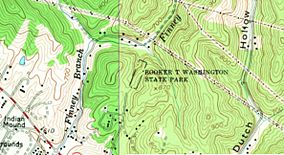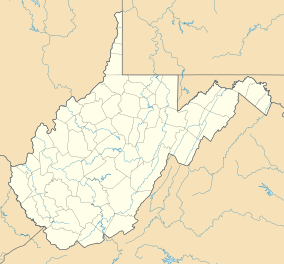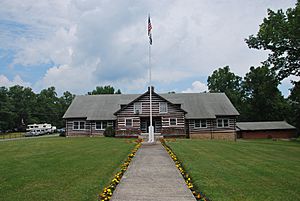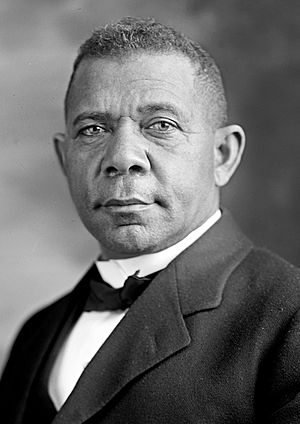Booker T. Washington State Park (West Virginia) facts for kids
Quick facts for kids Booker T. Washington State Park |
|
|---|---|

A topographic map from 1958 showing the location of Booker T. Washington State Park.
|
|
| Location | Institute, Kanawha, West Virginia, United States |
| Area | 7.43 acres (3.01 ha) |
| Elevation | 732 ft (223 m) |
| Established | 1949 |
| Named for | Booker T. Washington |
Booker T. Washington State Park was a special state park in West Virginia. It was located near the community of Institute. The park was open from 1949 until the late 1950s.
This park was important because it was originally set up for African Americans. At that time, many public places were segregated. This meant Black people and white people were kept separate. After a big court decision in 1954, the park became open to everyone. It was mainly a place for picnics and day trips.
Contents
Park Location and History
Booker T. Washington State Park was located just outside Institute. This area is in Kanawha County. The park was about 0.86 miles (1.4 km) east of the West Virginia State College campus.
Early History of the Area
Long ago, this area was home to Late Adena Native American groups. They built many large mounds and earthworks along the Kanawha River. Only a few of these mounds remain today.
Later, in the 1700s, George Washington owned a large amount of land here. In 1853, a man named Samuel I. Cabell bought a big piece of land. He and his wife, Mary Barnes Cabell, ran a farm there. After the American Civil War, their children and the people who had been enslaved on the farm settled the community of Piney Grove.
Founding of Institute and the College
In 1891, the West Virginia Legislature created the West Virginia Colored Institute. This school was for African Americans. It opened in Piney Grove in 1892. The town's name was then changed to Institute.
The institute became a key place for African American education in West Virginia. A famous African American educator, Booker T. Washington, often visited the school. He had grown up nearby. The state park was named after him in 1949.
Creating State Parks for Everyone
In the 1920s, West Virginia started creating its state park system. This was to protect nature and offer places for people to relax. By the mid-1930s, the state had many parks. However, these parks were not open to African Americans.
African American colleges in West Virginia worked to create outdoor activities for Black youth. In 1937, Camp Washington-Carver was built. This was a 4-H camp for African American children. It was named after Booker T. Washington and George Washington Carver. It was a very important place for outdoor education.
Park Opening and Integration
By 1945, West Virginia had 13 state parks. But African Americans were still not allowed in most of them. The NAACP asked why. State officials said they were thinking about building a park just for African Americans.
In 1949, private citizens donated 7.43 acres (3 ha) of land. This land was given to the state for a recreational area for African Americans. On August 5, 1949, the state announced the new park. It would be named Booker T. Washington State Park.
The park opened with basic facilities. It had a water well, picnic tables, fireplaces, and toilets. There was also a parking area for cars. Unlike other state parks, it did not have swimming, cabins, or hiking trails. It was the only state park open to African Americans.
A Big Change for the Park
In May 1954, the U.S. Supreme Court made a very important decision. This was the Brown v. Board of Education case. The court ruled that separate schools for Black and white children were illegal. This decision helped end segregation in many public places.
After this ruling, West Virginia announced that Booker T. Washington State Park would be integrated. This meant white people could now use the park too. State officials said it was the only park that had been segregated.
Booker T. Washington State Park continued to be a day-use park for picnics. However, by 1957, it no longer had a supervisor. By 1959, the park was no longer listed as a state park. It had closed down.
Park's Importance
Booker T. Washington State Park was the only state park ever to operate in Kanawha County. Even though it was open for a short time, it played a role in the history of civil rights in West Virginia. It showed the changes happening in the country during the time of segregation and integration.
Images for kids






